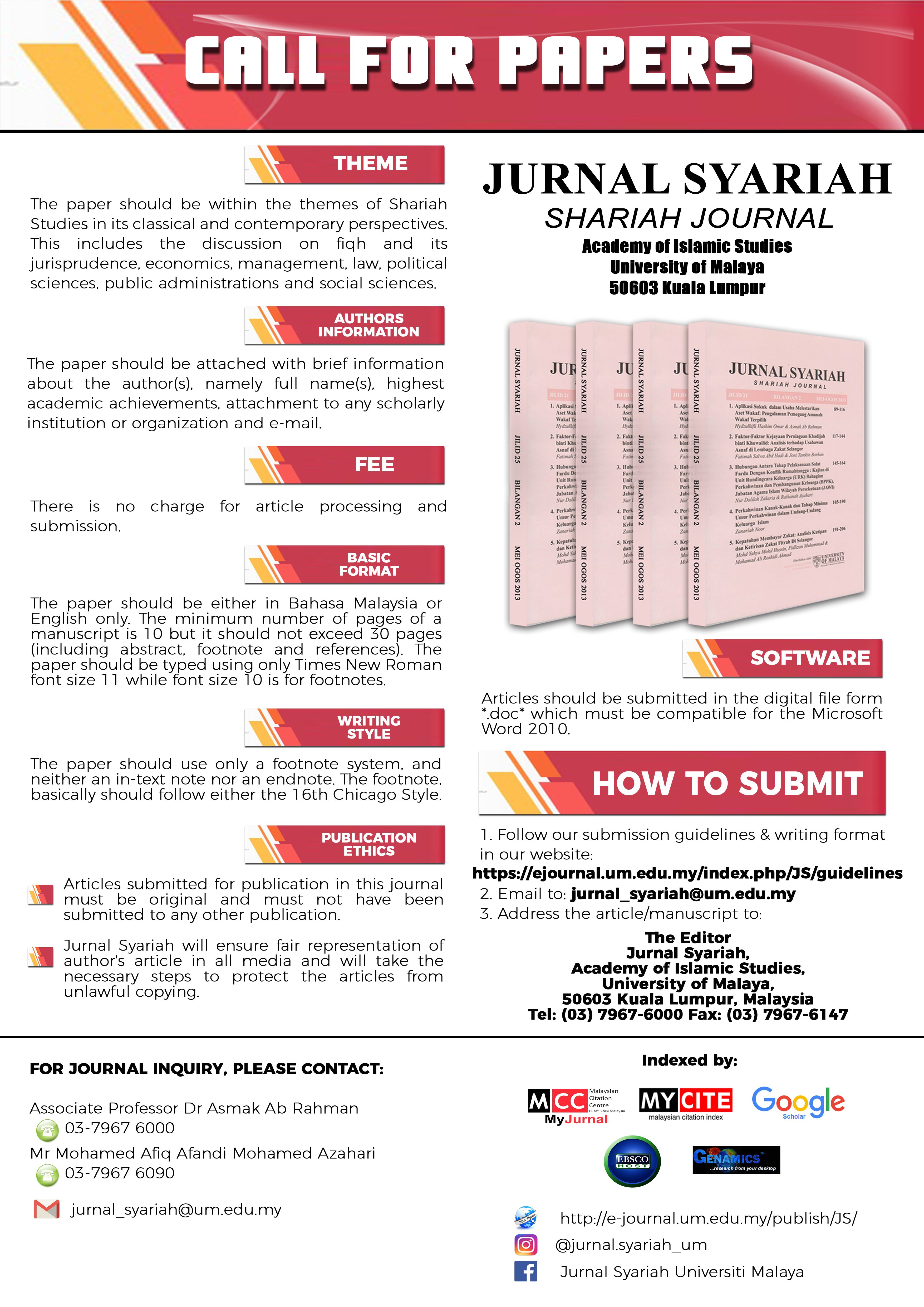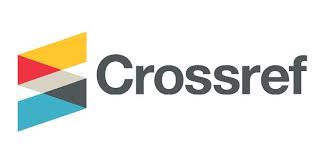DIGITAL WALLET ADOPTION FOR REPEAT INFAQ PAYMENT: INTEGRATING RELIGIOSITY – INTENTION MODEL
DOI:
https://doi.org/10.22452/syariah.vol30no1.2Keywords:
religiosity, donation, e-wallet, adoption, behavior intentionAbstract
This paper aims to investigate the integration of the TAM model and the religious intention model in the adoption of a digital wallet for sustainable infaq payments. The information was gathered through an online survey of 100 members of Gen-Z in Indonesia who use digital wallets and have made infaq payments using digital wallets. The relationship between religiosity, perceived ease of use, satisfaction, attitude, and intention to pay recurrent infaq is assessed using a quantitative approach and SEM techniques via smart-PLS. The results of the study show that the religious-intention integration model provides a more complete explanation regarding the adoption of digital wallets for recurring infaq payments. Apart from perceived ease of use, satisfaction, and attitudes, this research also focuses on how important religiosity is for digital wallet adoption. This research can be used by the government to increase the adoption of digital wallet services in Gen-Z and create a culture in the future to donate through digital wallets because their trust and feel it is easy to use. All marketing strategies must focus on providing high-quality digital wallet services and ensuring digital wallets comply with Islamic law so that Gen-Z is more aware of infaq through digital wallets.
Downloads
References
A. Bhattacherjee, ‘Understanding information systems continuance: an expectation-confirmation model’, MIS Quarterly 25/3 (2001): 351-370.
Abbasi, Ghazanfar Ali, Thiviya Sandran, Yuvaraj Ganesan, and Mohammad Iranmanesh, ‘Go cashless! Determinants of continuance intention to use E-wallet apps: A hybrid approach using PLS-SEM and fsQCA’, Technology in Society 68 (2022) 101937.
Ad-Dimasyqi, Imam Abu Fida’ Isma’il Ibnu Katsir, Muqaddimah Tafsir Al-Qur’anil Adzim, terj. Bahrun Abu Bakar (Bandung: Sinar Baru Algesindo, 2006).
Agarwala, R., Mishra, P. and Singh, R. ‘Religiosity and consumer behavior: a summarizing review’, Journal of Management, Spirituality and Religion 16/1 (2019): 32-54.
Aguinis, H., Edwards, J. R. and Bradley, K. J. ‘Improving our understanding of moderation and mediation in strategic management research’, Organizational Research Methods 20/4 (2017): 665-685.
Ahmad, Wan Marhaini Wan, Asmak Ab Rahman, Azizi Che Seman and Nor Aini Ali, ‘Religiosity and Banking Selection Criteria Among Malays in Lembah Klang’, Jurnal Syariah 16/2 (2008): 99-130.
Ain, Nurul dan Ratnasari, Ririn Tri, ‘Pengaruh Citra Merek melalui Sikap Konsumen terhadap Niat Beli Ulang pada Produk Busana Muslim Zoya Di Surabaya’, Jurnal Ekonomi Syariah Teori dan Terapan 2/7 (2015).
Aji, Hendy Mustiko, Albari Albari, Muchsin Muthohar, Sumadi Sumadi, Murwanto Sigit, Istyakara Muslichah and Anas Hidayat, ‘Investigating the determinants of online infaq intention during the COVID-19 pandemic: an insight from Indonesia’, Journal of Islamic Accounting and Business Research 12/1 (2021): 1-20.
Al-Bukhari, Abu Abdullah Muhammad bin Ismail, Ensiklopedia Hadits; Shahih al-Bukhari 1, Terj. Masyhar dan Muhammad Suhadi, Cet. I, (Jakarta: Almahira, 2011).
Ali, A., Xiaoling, G., Sherwani, M. and Ali, A. ‘Antecedents of consumers’ halal brand purchase intention: an integrated approach’, Management Decision 56/4 (2018): 715-735.
Aziz, S., Md Husin, M., Hussin, N. and Afaq, Z. ‘Factors that influence individuals’ intentions to purchase family Takaful mediating role of perceived trust’, Asia Pacific Journal of Marketing and Logistics 31/1 (2019): 81-104.
B. Foroughi, M. Iranmanesh, S.S. Hyun, ‘Understanding the determinants of mobile banking continuance usage intention’, Journal Enterprise Inf. Manag. 32/6 (2019): 1015–1033.
Bashir, Irfan and Chendragiri Madhavaiah, ‘Consumer attitude and behavioural intention towards Internet banking adoption in India’, Journal of Indian Business Research 7/1 (2014): 67-102.
Basoeky, U., Panggabean, S., Manu, G. A., Wardhana, A., Hoeronis, I., Adnan, Y., Maisarah, & Sudirman, A. Pemanfaatan Teknologi Digital: Dalam Berbagai Aspek Kehidupan Masyarakat (Jakarta: Media Sains Indonesia, 2021).
Beldad, Ardion, Jordy Gosselt, Sabrina Hegner and Robin Leushuis, ‘Generous But Not Morally Obliged? Determinants of Dutch and American Donors’ Repeat Donation Intention (REPDON)’, Voluntas 26 (2015): 442–465.
Beldad, Ardion, Snip, B. and van Hoof, J. ‘Generosity the second time around: determinants of individuals’ repeat donation intention’, Nonprofit and Voluntary Sector Quarterly 43/1 (2014): 144-163.
Branston, K. and Bush, L. ‘The nature of online social good networks and their impact on non-profit organization and users’, Prism. 7/2 (2010).
C.L. Hsu, Y.C. Chen, T.N. Yang, W.K. Lin, ‘Do website features matter in an online gamification context? Focusing on the mediating roles of user experience and attitude’, Telematics Inf. 34/4 (2017): 196–205.
Carlson, Jamie and Aron O’Cass. ‘Exploring the relationships between e-service quality, satisfaction, attitudes and behaviours in content-driven e-service web sites’, Journal of Services Marketing 24/2 (2010): 112–127.
Castillo, M., Petrie, R., Wardell, C. ‘Fundraising through online social networks: a field experiment on peer-to-peer solicitation’, J. Public Econ. 114 (2014): 29–35.
Chen, H. J. ‘What drives consumers’ mobile shopping? 4Ps or shopping preferences?’, Asia Pacific Journal of Marketing and Logistics 30/4 (2018): 797-815.
Daragmeh, Ahmad, Judit Sági, and Zoltán Zéman, ‘Continuous Intention to Use E-Wallet in the Context of the COVID-19 Pandemic: Integrating the Health Belief Model (HBM) and Technology Continuous Theory (TCT)’, Journal of Open Innovation: Technology, Market, and Complexity 7 (2021): 132.
Deng, Z., Lu, Y., Wei, K. K. and Zhang, J. ‘Understanding customer satisfaction and loyalty: an empirical study of mobile instant messages in China’, International Journal of Information Management 30/4 (2010): 289-300.
F. Calisir, C. Altin Gumussoy, A.E. Bayraktaroglu, D. Karaali, ‘Predicting the intention to use a web-based learning system: perceived content quality, anxiety, perceived system quality, image, and the technology acceptance model, Human Factors Ergonomics Manufacture’, Service Industries 24/5 (2014): 515–531.
Fishbein, M. and Ajzen, I. Belief, Attitude, Intention and Behavior: An Introduction to Theory and Research. (Addison-Wesley Pub. Co., Reading, Mass. 1975).
Foroughi, B., Iranmanesh, M. and Hyun, S.S. ‘Understanding the determinants of mobile banking continuance usage intention’, Journal of Enterprise Information Management 32/6 (2019): 1015-1033.
Fortin, M. C., Dion-Labrie, M., Hébert, M. J. and Doucet, H. ‘The enigmatic nature of altruism in organ transplantation: a cross-cultural study of transplant physicians’ views on altruism’, BMC Research Notes 3/1 (2010): 216.
Gao, L., Waechter, K. A. and Bai, X. ‘Understanding consumers’ continuance intention towards mobile purchase: a theoretical framework and empirical study–A case of China’, Computers in Human Behavior 53 (2015): 249-262.
Gefen, David, Karahanna, E. and Straub, D. W. ‘Trust and TAM in online shopping: an integrated model’, MIS Quarterly 27/1 (2003): 51-90.
Ghozali, Imam, Structural Equation Modelling, Edisi II (Semarang: Universitas Diponegoro, 2008).
GoPay dan Kopernik, ‘Gopay Digital Donation Outlook 2020’, Gopay (2020): 27-28, https://v1.kopernik.info/documents/document/1608187207118_8549.pdf, accessed on 4 January 2023.
Grace, D. and O’Cass, A. ‘Examining the effects of service brand communications on brand evaluation’, Journal of Product & Brand Management 14/2 (2005): 106-16.
Haque, A., Rahman, S. and Yasmin, F. ‘Exploring the relationship between religiosity, ethnocentrism and corporate image: young Muslim consumers perspective’, Journal of Business and Policy Research 7/1 (2012): 60-71.
Hoque, Mohammad Enamul, Nik Mohd Hazrul Nik Hashim and Mohammad Hafizi Bin Azmi, ‘Moderating effects of marketing communication and financial consideration on customer attitude and intention to purchase Islamic banking products: A conceptual framework’, Journal of Islamic Marketing 9/4 (2018): 799-822.
Jamshidi, D. and Hussin, N. ‘Forecasting patronage factors of an Islamic credit card as a new ecommerce banking service: an integration of TAM with perceived religiosity and trust’, Journal of Islamic Marketing 7/4 (2016): 378-404.
Kailani, N. and Slama, M. ‘Accelerating Islamic charities in Indonesia: zakat, sedekah and the immediacy of social media’, South East Asia Research 28/1 (2020): 70-86.
Kasri, R. A. and Ramli, U. H. ‘Why do Indonesian Muslims donate through mosques? A theory of planned behaviour approach’, International Journal of Islamic and Middle Eastern Finance and Management 12/5 (2019): 663-679.
Khraim, H. ‘Measuring religiosity in consumer research from an Islamic perspective’, Journal of Economic and Administrative Sciences 26/1 (2010): 52-78.
Kim, Y. and Lee, W. ‘Networking for philanthropy: increasing volunteer behavior via social networking sites’, Cyberpsychol. Behav. Soc. Netw. 17/3 (2014): 160–165.
Knowles, S.S., Hyde, M.K., White, K.M. ‘Predictors of young people’s charitable intentions to donate money: an extended theory of planned behavior perspective’, J. Appl. Soc. Psychol. 42/9 (2012): 2096–2110.
Kotler, Philip and Kevin Lane Keller, Marketing Management, 14th Edition. Upper Saddle River (N.J.: Pearson Prentice Hall, 2012).
Kotler, Philip and Kevin Lane Keller, Manajemen Pemasaran. Edisi 13 Jilid 2 (Jakarta: Erlangga, 2009).
Madan, K. and Yadav, R. ‘Behavioural intention to adopt mobile wallet: a developing country perspective’, Journal of Indian Business Research 8/3 (2016): 227–244.
Mansumitrchai, Somkiat and Husam-Aldin N. AL-Malkawi, ‘Factors Underlying the Adoption of Online Banking by Mexican Consumers’, International Journal of Business and Management 6/9 (2011): 155-169.
Md Husin, Maizaitulaidawati and Asmak Ab Rahman, ‘Predicting intention to participate in family takaful scheme using decomposed theory of planned behaviour’, International Journal of Social Economics 43/12 (2016): 1351-1366.
Md Husin, Maizaitulaidawati and Asmak Ab Rahman, ‘Do Muslims intend to participate in Islamic insurance? Analysis from theory of planned behaviour’, Journal of Islamic Accounting and Business Research 7/1 (2016): 42-58.
Md Taib, F. M., Ramayah T., and Razak D. A. ‘Factor influencing intention to use diminishing partnership home financing’, Int. J. of Islamic and Middle Eastern Finance and Management 1/ 3 (2008): 235-248.
Mokhlis, S. ‘Religious differences in some selected aspects of consumer behaviour: a Malaysian study’, The Journal of International Management Studies 4/1 (2009): 67-76.
Mokhlis, Safiek, ‘Relevancy and measurement of religiosity in consumer behavior research’, International Business Research 2/3 (2009): 75–84.
Mukhtar, A. and Mohsin Butt, M. ‘Intention to choose halal products: the role of religiosity’, Journal of Islamic Marketing 3/2 (2012): 108-120.
Nizar, S. and Marzouki, R. ‘Consumer attitudes and purchase intentions toward Islamic banks: the influence of religiosity’, International Journal of Bank Marketing 33/2 (2015): 143-161.
Nunnally, J. C. and Bernstein, I. H. Psychometric Theory, 3/e (New York, NY: McGraw-Hill, 1994).
Oppenheim, C. dan Ward, L. ‘Evaluation of web sites for B2C e-commerce’, Aslib Proceedings: New Information Perspectives 58/3 (2006): 237-260.
Osman, Amirul Faiz, Mustafa Omar Mohammed and Aiman Fadzil, ‘Factor influencing cash waqf giving behavior: a revised theory of planned behavior’, Journal of Global Business and Social Entrepreneurship 1/ 2 (2015): 12-25.
Pappas, Ilias O., Adamantia G. Pateli, Michail N. Giannakos, and Vassilios Chrissikopoulos, ‘Moderating effects of onlineshopping experience on customersatisfaction and repurchase intentions’, International Journal of Retail & Distribution Management 42/3 (2013): 187-204.
Parakh S.D and Barbole A. N. ‘The study of consumer’s perspective About internet banking: empirical evidence from western Maharashtra’, Indian Stream Research Journal 3/3 (2013).
Parakh, Santosh, Prakash Ukhalkar and Leena Sanu, ‘Digital Wallet and Mobile Banking Adoption Among Rural Bank Customer’, International Research Journal of Business Studies XIII/03 (2020).
Pauli, Jandir, Kenny Basso and Juliane Ruffatto, ‘The influence of beliefs on organ donation intention’, International Journal of Pharmaceutical and Healthcare Marketing 11/3 (2017): 291-308.
Perkins, Ed-Zilla Daniel and Annan Jonathan, ‘Factors affecting the Adoption of Online Banking in Ghana: Implications for Bank Managers’, International Journal of Business and Social Research (IJBSR) 3/6 (2013): 94-108.
Phau, I. and Teah, M. ‘Devil wears (counterfeit) Prada: a study of antecedents and outcomes of attitudes towards counterfeits of luxury brands’, Journal of Consumer Marketing 26/1 (2009): 15–27.
Rahi, S., Khan, M.M. and Alghizzawi, M. ‘Extension of technology continuance theory (TCT) with task technology fit (TTF) in the context of Internet banking user continuance intention’, International Journal of Quality & Reliability Management 38/4 (2021): 986-1004.
Raman, Prashant and Kumar Aashish, ‘To continue or not to continue: a structural analysis of antecedents of mobile payment systems in India’, International Journal of Bank Marketing 39/2 (2020): 242-271.
Rana, N. P., Dwivedi, Y. K., Williams, M. D., & Weerakkody, V. ‘Investigating success of an e-government initiative: Validation of an integrated IS success model’, Information Systems Frontiers 17/1 (2015): 127–142.
Ratnasari, Ririn Tri, Sri Gunawan, Dina Fitrisia Septiarini, Sylva Alif Rusmita, and Kusuma Chandra Kirana, ‘Customer Satisfaction Between Perceptions of Environment Destination Brand and Behavioural Intention’, International Journal of Innovation, Creativity and Change 10/12 (2020).
Ratnasari, Ririn Tri, Sri Gunawan, Imron Mawardi and Kusuma Chandra Kirana, ‘Emotional experience on behavioral intention for halal tourism’, Journal of Islamic Marketing (2020).
Ratnasari, Ririn Tri, Ulfa Fadilatul Ula and Raditya Sukmana, ‘Can store image moderate the influence of religiosity level on shopping orientation and customers’ behavior in Indonesia?’, Journal of Islamic Accounting and Business Research (2020).
Ratten, V. ‘International consumer attitudes toward cloud computing: a social cognitive theory and technology acceptance model perspective’, Thunderbird International Business Review 57/3 (2015): 217-228.
Safrilsyah, Baharudin R., and Duraseh, N, ‘Religiusitas Dalam Perspektif Islam: Suatu Kajian Psikologi Agama’, Substantia 12/2 (2010): 399-412.
Salam, M. T., Muhamad, N. and Leong, V. S. ‘Measuring religiosity among Muslim consumers: observations and recommendations’, Journal of Islamic Marketing 10/2 (2019): 633-652.
Schiffman and Kanuk, Perilaku Konsumen (edisi 7) (Jakarta: Prentice Hall, 2004).
Seo, S., Kim, K. and Nurhidayati Vieta, A. ‘Satisfaction and purchase intention of imported fresh fruits based on familiarity: a case of Korean pears in Taiwan’, British Food Journal 122/9 (2020): 2895-2910.
Setiowati, Apriliani Kartika, Widayat, and Jasly By, ‘Sikap online shopping dan niat pencarian informasi terhadap niat dan perilaku belanja’, Jurnal Manajemen Bisnis 2/01 (2012).
Sholihin, M. dan D. Ratmono, Analisis SEM-PLS dengan WarpPLS 3.0 untuk Hubungan Non-Linear dalam Penelitian Sosial & Bisnis (Yogyakarta: Andi, 2013).
Singh, S. and Srivastava, R.K. ‘Predicting the intention to use mobile banking in India’, International Journal of Bank Marketing 36/2 (2018): 357-378.
Slack, Neale, Gurmeet Singh, and Shavneet Sharma, ‘The effect of supermarket service quality dimensions and customer satisfaction on customer loyalty and disloyalty dimensions’, International Journal of Quality and Service Sciences 12/3 (2020): 297-318.
Smith, J. and McSweeney, A. ‘Charitable Giving: The Effectiveness of a Revised Theory of Planned Behaviour Model in Predicting Donating Intentions and Behavior’, Journal of Community and Applied Social Psychology 17/5 (2007): 363–386.
Souiden, N. and Jabeur, Y. ‘The impact of Islamic beliefs on consumers’attitudes and purchase intentions of life insurance’, International Journal of Bank Marketing 33/4 (2015): 423-441.
Sudirman, A., Alaydrus, S., Rosmayati, S., Syamsuriansyah, Nugroho, L., Arifudin, O., Hanika, I. M., & Haerany, A. Perilaku Konsumen dan Perkembangannya di Era Digital (Bandung: Widina Bhakti Persada, 2020).
Sugiyono, Metode Penelitian Pendidikan Pendekatan Kuantitatif, Kualitatif, dan R&D (Bandung: Alfabeta, 2010).
Suhartanto, D., Farhani, N.H., Muflih, M. and Setiawan, S. ‘Loyalty intention towards Islamic bank: the role of religiosity, image, and trust’, International Journal of Economics and Management 12/1 (2018): 137-151.
Suhartanto, Dwi, David Dean, Tuan Ahmad Tuan Ismail and Ratna Sundari, ‘Mobile banking adoption in Islamic banks: Integrating TAM model and religiosity-intention model’, Journal of Islamic Marketing 11/6 (2020): 1405-1418.
Suhartanto, Dwi, ‘Predicting behavioural intention toward Islamic bank: a multi-group analysis approach’, Journal of Islamic Marketing (2019): 1-13.
Sura, Suaini, Jongchang Ahn and Ook Lee, ‘Factors influencing intention to donate via social network site (SNS): From Asian’s perspective’, Telematics and Informatics 34/1 (2017): 164-176.
Teah, M., Lwin, M. and Cheah, I. ‘Moderating role of religious beliefs on attitudes toward charities and motivation to donate’, Asia Pacific Journal of Marketing and Logistics 26/5 (2014): 738-760.
Treiblmaier, H., Pollach, I. ‘A framework for measuring people’s intention to donate online’, PACIS 2006 Proceeding, AISeL (2006): 808-817.
Usman, Hardius, ‘Islamic religiosity scale, and its applied on the relationship between religiosity and selection of Islamic bank’, Journal of Distribution Science 14/2 (2016): 23-32.
Venkatesh, V., Morris, M.G., Davis, G.B. and Davis, F.D. ‘User acceptance of information technology: toward a unified view’, MIS Quarterly 27/3 (2003): 425-478.
Vitell, S.J. and Paolillo, J.G.P. ‘Consumer Ethics: The Role of Religiosity’, Journal of Business Ethics 46/2 (2003): 151-162.
Wallace, L.G. and Sheetz, S.D. ‘The adoption of software measures: a technology acceptance model (TAM) perspective’, Information and Management 51/2 (2014): 249-259.
Wang, R. and Tseng, M.L. ‘Evaluation of international student satisfaction using fuzzy importance-performance analysis’, Procedia – Social and Behavioral Sciences 25 (2011): 438- 446.
Widyanto, Hanif Adinugroho and Imaduena Aesa Tibela Sitohang, ’Muslim millennial’s purchase intention of halal-certified cosmetics and pharmaceutical products: the mediating effect of attitude’, Journal of Islamic Marketing (2021).
Wu, Wen-Tsung, Chie-Bein Chen and Chiao-Chen Chang, ‘Applying the Analytic Hierarchy Process Decision Analysis to Better Understand Adoption Intentions of Mobile Banking’, Business and Economic Research 5/1 (2016): 431-439.
Xiao, Yi, Xiaoling Ren, Pei Zhang and Antonnette Ketlhoafetse, ‘The effect of service quality on foreign participants’ satisfaction and behavioral intention with the 2016 Shanghai International Marathon’, International Journal of Sports Marketing and Sponsorship 21/1 (2019): 91-105.
Yeo, V. C. S., Goh, S. K., and Rezaei, S. ‘Consumers Experiences, Attitude and Behavioral Intention Toward Online Food Delivery (OFD) Services’, Journal of Retailing and Consumer Services 35 (2017): 150-162.
Yuswohady, ‘Industry Outlook 2021 Conference: Consumer Megashift Post Covid-19’ (Jakarta, 27 Oktober 2020).
Downloads
Published
How to Cite
Issue
Section
License
Copyright (c) 2023 Jurnal Syariah

This work is licensed under a Creative Commons Attribution-NonCommercial 4.0 International License.
COPYRIGHT: All rights reserved. Not allowed to be reproduced any part of articles and contents of this journal in any form or by any way, whether electronic, mechanical, photocopying, recording or otherwise without permission in writing from the Chief Editor, Jurnal Syariah.



















